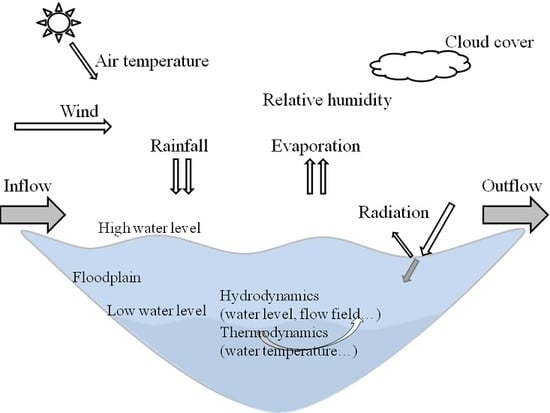Investigation of Water Temperature Variations and Sensitivities in a Large Floodplain Lake System (Poyang Lake, China) Using a Hydrodynamic Model
Abstract
:1. Introduction
2. Materials and Methods
2.1. Study Area
2.2. Data Availability
2.2.1. Routine Observation Data
2.2.2. Field Data and Remote Sensing Images
2.3. Meteorological and Hydrological Conditions
2.4. Hydrodynamic Model Description and Setup
2.5. Model Calibration and Skill Assessment
2.6. Sensitivity Analysis Approach
3. Results
3.1. Hydrodynamic Model Calibration
3.2. Spatial and Temporal Variability of Lake Water Temperature
3.3. Sensitivity Analysis
4. Discussion
5. Conclusions
Acknowledgments
Author Contributions
Conflicts of Interest
References
- Willamson, C.E.; Dodds, W.; Kratz, T.K.; Palmer, M.A. Lakes and streams as sentinels of environmental change in terrestrial and atmospheric processes. Front. Ecol. Environ. 2008, 6, 247–254. [Google Scholar] [CrossRef]
- Adrian, R.; OReilly, C.M.; Zagarese, H.; Baines, S.B.; Hessen, D.O.; Keller, W.; Livingstone, D.M.; Sommaruga, R.; Straile, D.; Van Donk, E.; et al. Lakes as sentinels of climate change. Limnol. Oceanogr. 2009, 54, 2283–2297. [Google Scholar] [CrossRef] [PubMed] [Green Version]
- Woolway, R.I.; Merchant, C.J. Amplified surface temperature response of cold, deep lakes to inter-annual air temperature variability. Sci. Rep. 2017, 7, 1–8. [Google Scholar] [CrossRef] [PubMed]
- Sima, S.; Ahmadalipour, A.; Tajrishy, M. Mapping surface temperature in a hyper-saline lake and investigating the effect of temperature distribution on the lake evaporation. Remote Sens. Environ. 2013, 136, 374–385. [Google Scholar] [CrossRef]
- Allan, M.G.; Hamilton, D.P.; Trolle, D.; Muraoka, K. Spatial heterogeneity in geothermally-influenced lakes derived from atmospherically corrected Landsat thermal imagery and three-dimensional hydrodynamic modelling. Int. J. Appl. Earth Obs. 2016, 50, 106–116. [Google Scholar] [CrossRef]
- Trumpickas, J.; Shuter, B.J.; Minns, C.K. Foresting impacts of climate change on Great Lakes surface water temperature. J. Great Lakes Res. 2009, 35, 454–463. [Google Scholar] [CrossRef]
- Hlevca, B.; Cooke, S.J.; Midwood, J.D.; Doka, S.E.; Portiss, R.; Wells, M.G. Characterisation of water temperature variability within a harbour connected to a large lake. J. Great Lakes Res. 2015, 41, 1010–1023. [Google Scholar] [CrossRef]
- Coll, C.; Caselles, V.; Galve, J.M.; Valor, E.; Niclòs, R.; Sánchez, J.M.; Rivas, R. Ground measurements for the validation of land surface temperatures derived from AATSR and MODIS data. Remote Sens. Environ. 2005, 97, 288–300. [Google Scholar] [CrossRef]
- Schneider, P.; Hook, S.J. Space observations of inland water bodies show rapid surface warming since 1985. Geophys. Res. Lett. 2010, 37, L22405. [Google Scholar] [CrossRef]
- Safaie, A.; Litchman, E.; Phanikumar, M.S. Evaluating the role of groundwater on circulation and thermal structure in a deep inland lake. Adv. Water Resour. 2017, 108, 310–327. [Google Scholar] [CrossRef]
- Webb, B.W.; Hannah, D.M.; Moore, R.D.; Brown, L.E.; Nobilis, F. Recent advances in stream and river temperature research. Hydrol. Process. 2008, 22, 902–918. [Google Scholar] [CrossRef]
- Javaheri, A.; Babbar-Sebens, M.; Miller, R.N. From skin to bulk: An adjustment technique for assimilation of satellite-derived temperature observations in numerical models of small inland water bodies. Adv. Water Resour. 2016, 92, 284–298. [Google Scholar] [CrossRef]
- MacCallum, S.N.; Merchant, C.J. Surface water temperature observations of large lakes by optimal estimation. Can. J. Remote Sens. 2012, 38, 25–44. [Google Scholar] [CrossRef]
- Torbick, N.; Ziniti, B.; Wu, S.; Linder, E. Spatiotemporal lake skin summer temperature trends in the northeast United States. Earth Interact. 2016, 20, 1–21. [Google Scholar] [CrossRef]
- Politi, E.; Cutler, M.E.J.; Rowan, J.S. Using the NOAA Advanced Very High Resolution Radiometer to characterise temporal and spatial trends in water temperature of large European lakes. Remote Sens. Environ. 2012, 126, 1–11. [Google Scholar] [CrossRef] [Green Version]
- Moukomla, S.; Blanken, P.D. Remote sensing of the North American Laurentian Great Lakes’ surface temperature. Remote Sens. 2016, 8, 286. [Google Scholar] [CrossRef]
- Riffler, M.; Lieberherr, G.; Wunderle, S. Lake surface water temperatures of European Alpine lakes (1989–2013) based on the Advanced Very High Resolution Radiometer (AVHRR) 1 km data set. Earth Syst. Sci. Data 2015, 7, 1–17. [Google Scholar] [CrossRef]
- Mahanty, M.M.; Mohanty, P.K.; Pattnaik, A.K.; Panda, U.S.; Pradhan, S.; Samal, R.N. Hydrodynamics, temperature/salinity variability and residence time in the Chilika lagoon during dry and wet period: Measurement and modelling. Cont. Shelf Res. 2016, 125, 28–43. [Google Scholar] [CrossRef]
- Bueche, T.; Vetter, M. Simulating water surface temperature and stratification of a pre-alpine lake with a hydrodynamic model: Calibration and sensitivity analysis of climatic input parameters. Hydrol. Process. 2014, 28, 1450–1464. [Google Scholar] [CrossRef]
- Xue, P.; Schwab, D.J.; Hu, S. An investigation of the thermal response to meteorological forcing in a hydrodynamic model of Lake Superior. J. Geophys. Res. Oceans 2015, 120, 5233–5253. [Google Scholar] [CrossRef]
- Zhong, Y.; Notaro, M.; Vavrus, S.; Foster, M.J. Recent accelerated warming of the Laurentian Great Lakes: Physical drivers. Limnol. Oceanogr. 2016, 61, 1762–1786. [Google Scholar] [CrossRef]
- Pahlevan, N.; Garrett, A.J.; Gerace, A.D.; Schott, J.R. Integrating Landsat-7 imagery with physics-based models for quantitative mapping of coastal waters near river discharges. Photogramm. Eng. Remote Sens. 2012, 78, 1163–1174. [Google Scholar] [CrossRef]
- Weinberger, S.; Vetter, M. Using the hydrodynamic model DYRESM based on results of a regional climate model to estimate water temperature changes at Lake Ammersee. Ecol. Model. 2012, 244, 38–48. [Google Scholar] [CrossRef]
- Buccola, N.L.; Risley, J.C.; Rounds, S.A. Simulating future water temperatures in the North Santiam River, Oregon. J. Hydrol. 2016, 535, 318–330. [Google Scholar] [CrossRef]
- Shankman, D.; Heim, B.D.; Song, J. Flood frequency in China’s Poyang Lake region: Trends and teleconnections. Int. J. Climatol. 2006, 26, 1255–1266. [Google Scholar] [CrossRef]
- Feng, L.; Hu, C.; Chen, X.; Cai, X.; Tian, L.; Gan, W. Assessment of inundation changes of Poyang Lake using MODIS observation between 2000 and 2010. Remote Sens. Environ. 2012, 121, 80–92. [Google Scholar] [CrossRef]
- Guo, H.; Hu, Q.; Zhang, Q.; Feng, S. Effects of the Three Gorges Dam on Yangtze River flow and river interaction with Poyang Lake, China: 2003–2008. J. Hydrol. 2012, 416–417, 19–27. [Google Scholar] [CrossRef]
- Zhang, Q.; Ye, X.C.; Werner, A.D.; Li, Y.L.; Yao, J.; Li, X.H.; Xun, C.Y. An investigation of enhanced recessions in Poyang Lake: Comparison of Yangtze River and local catchment impacts. J. Hydrol. 2014, 517, 425–434. [Google Scholar] [CrossRef]
- Cheng, X.; Li, S. An analysis on the evolvement processes of lake eutrophication and their characteristics of the typical lakes in the middle and lower reaches of Yangtze River. Chin. Sci. Bull. 2006, 51, 1603–1613. [Google Scholar] [CrossRef]
- Yao, X.; Wang, S.; Ni, Z.; Jiao, L. The response of water quality variation in Poyang Lake (Jiangxi, People’s Republic of China) to hydrological changes using historical data and DOM fluorescence. Environ. Sci. Pollut. Res. 2015, 22, 3032–3042. [Google Scholar] [CrossRef] [PubMed]
- Liu, X.; Li, Y.L.; Liu, B.G.; Qian, K.M.; Chen, Y.W.; Gao, J.F. Cyanobacteria in the complex river-connected Poyang Lake: Horizontal distribution and transport. Hydrobiologia 2016, 768, 95–110. [Google Scholar] [CrossRef]
- Wu, Z.; Lai, X.; Zhang, L.; Cai, Y.; Chen, Y. Phytoplankton chlorophyll a in Lake Poyang and its tributaries during dry, mid-dry and wet seasons: A 4-year study. Knowl. Manag. Aquat. Ecosyst. 2014, 412, 1–13. [Google Scholar]
- Li, B.; Yang, G.; Wan, R.; Hörmann, G.; Huang, J.; Fohrer, N.; Zhang, L. Combining multivariate statistical techniques and random forests model to asses and diagnose the trophic status of Poyang Lake in China. Ecol. Indic. 2017, 83, 74–83. [Google Scholar] [CrossRef]
- Kanai, Y.; Ueta, M.; Germogenov, N.; Nagendran, M.; Mita, N.; Higuchi, H. Migration routes and important resting areas of Siberian cranes (Grus leucogeranus) between northeastern Siberia and China as revealed by satellite tracking. Biol. Conserv. 2002, 106, 339–346. [Google Scholar] [CrossRef]
- Zhen, L.; Li, F.; Huang, H.; Dilly, O.; Liu, J.; Wei, Y.; Yang, L.; Cao, X. Households’ willingness to reduce pollution threats in the Poyang Lake region, southern China. J. Geochem. Explor. 2011, 110, 15–22. [Google Scholar] [CrossRef]
- Li, Y.L.; Zhang, Q.; Werner, A.D.; Yao, J.; Ye, X.C. The influence of river-to-lake backflow on the hydrodynamics of a large floodplain lake system (Poyang Lake, China). Hydrol. Process. 2017, 31, 117–132. [Google Scholar] [CrossRef]
- Chen, M.; Wei, X.; Huang, H.; Lu, T. Poyang Lake basin: A successful, large-scale integrated basin management model for developing counties. Water Sci. Technol. 2011, 63, 1899–1905. [Google Scholar] [CrossRef] [PubMed]
- Woolway, R.I.; Maberly, S.C.; Jones, I.D.; Feuchtmayr, H. A novel method for estimating the onset of thermal stratification in lakes from surface water measurements. Water Resour. Res. 2014, 50, 5131–5140. [Google Scholar] [CrossRef] [Green Version]
- Li, Y.L.; Yao, J.; Zhang, L. Investigation into mixing in the shallow floodplain Poyang Lake (China) using hydrological, thermal and isotopic evidence. Water Sci. Technol. 2016, 74, 2582–2598. [Google Scholar] [CrossRef] [PubMed]
- Li, Y.L.; Zhang, Q.; Werner, A.D.; Yao, J. Investigating a complex lake-catchment-river system using artificial neural networks: Poyang Lake (China). Hydrol. Res. 2015, 46, 912–928. [Google Scholar] [CrossRef]
- Hu, Q.; Feng, S.; Guo, H.; Chen, G.Y.; Jiang, T. Interactions of the Yangtze River flow and hydrologic processes of the Poyang Lake, China. J. Hydrol. 2007, 347, 90–100. [Google Scholar] [CrossRef]
- Li, Y.L.; Zhang, Q.; Yao, J.; Werner, A.D.; Li, X.H. Hydrodynamic and hydrological modeling of Poyang Lake catchment system in China. J. Hydrol. Eng. 2014, 19, 607–616. [Google Scholar] [CrossRef]
- Li, Y.L.; Zhang, Q.; Yao, J. Investigation of residence and travel time in a large floodplain lake with complex lake-river interactions: Poyang Lake (China). Water 2015, 7, 1991–2012. [Google Scholar] [CrossRef]
- Wilson, J.; Rocha, C. Regional scale assessment of submarine groundwater discharge in Ireland combining medium resolution thermal imagery and geochemical tracing techniques. Remote Sens. Environ. 2012, 119, 21–34. [Google Scholar] [CrossRef]
- Barsi, J.A.; Schott, J.R.; Palluconi, F.D.; Helder, D.L.; Hook, S.J.; Markham, B.L. Landsat TM and ETM+ thermal band calibration. Can. J. Remote Sens. 2003, 29, 141–153. [Google Scholar] [CrossRef]
- Danish Hydraulic Institute (DHI). MIKE 21 Flow Model: Hydrodynamic Module User Guide; Danish Hydraulic Institute Water and Environment: Hørsholm, Denmark, 2014; p. 132. [Google Scholar]
- Zhang, Q.; Werner, A.D. Hysteretic relationships in inundation dynamics for a large lake-floodplain system. J. Hydrol. 2015, 527, 160–171. [Google Scholar] [CrossRef]
- Sahlberg, J. A Hydrodynamic Model for Heat Contents Calculations on Lakes at the Ice Formation Date; Document D4: 1984; Swedish Council for Building Research: Stockholm, Sweden, 1984. [Google Scholar]
- Kantha, L.H.; Clayson, C.A. Small Scale Processes in Geophysical Fluid Flows; International Geophysics; Academic Press: Waltham, MA, USA, 2000; Volume 67. [Google Scholar]
- Imberger, J. Thermal characteristics of standing waters: An illustration of dynamic processes. Hydrobiologia 1985, 125, 7–29. [Google Scholar] [CrossRef]
- Feng, L.; Hu, C.; Chen, X.; Li, R.; Tian, L.; Murch, B. MODIS observations of the bottom topography and its inter-annual variability of Poyang Lake. Remote Sens. Environ. 2011, 115, 2729–2741. [Google Scholar] [CrossRef]
- Jiao, L. Scientists line up against dam that would alter protected wetlands. Science 2009, 326, 508–509. [Google Scholar] [CrossRef] [PubMed]
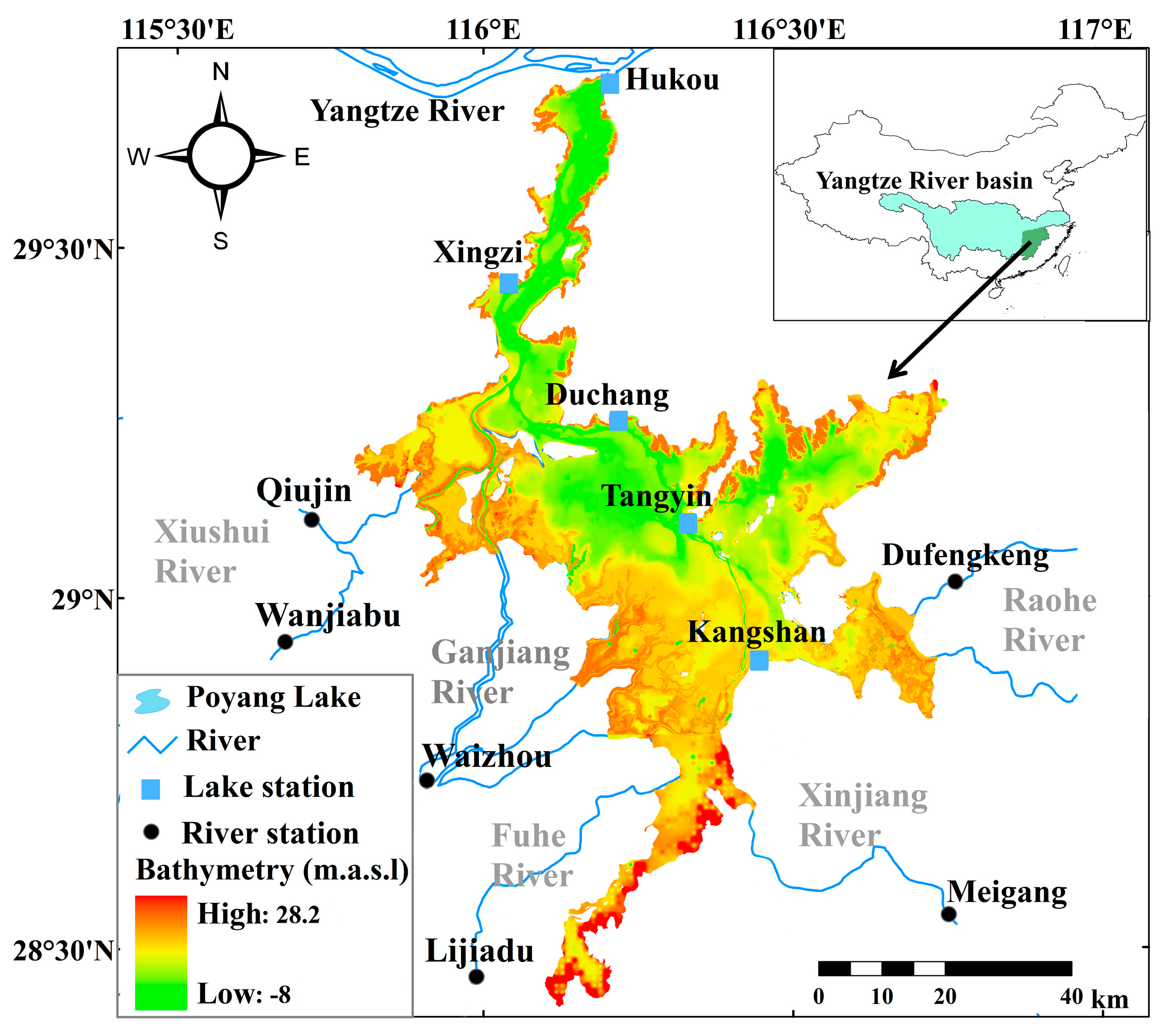
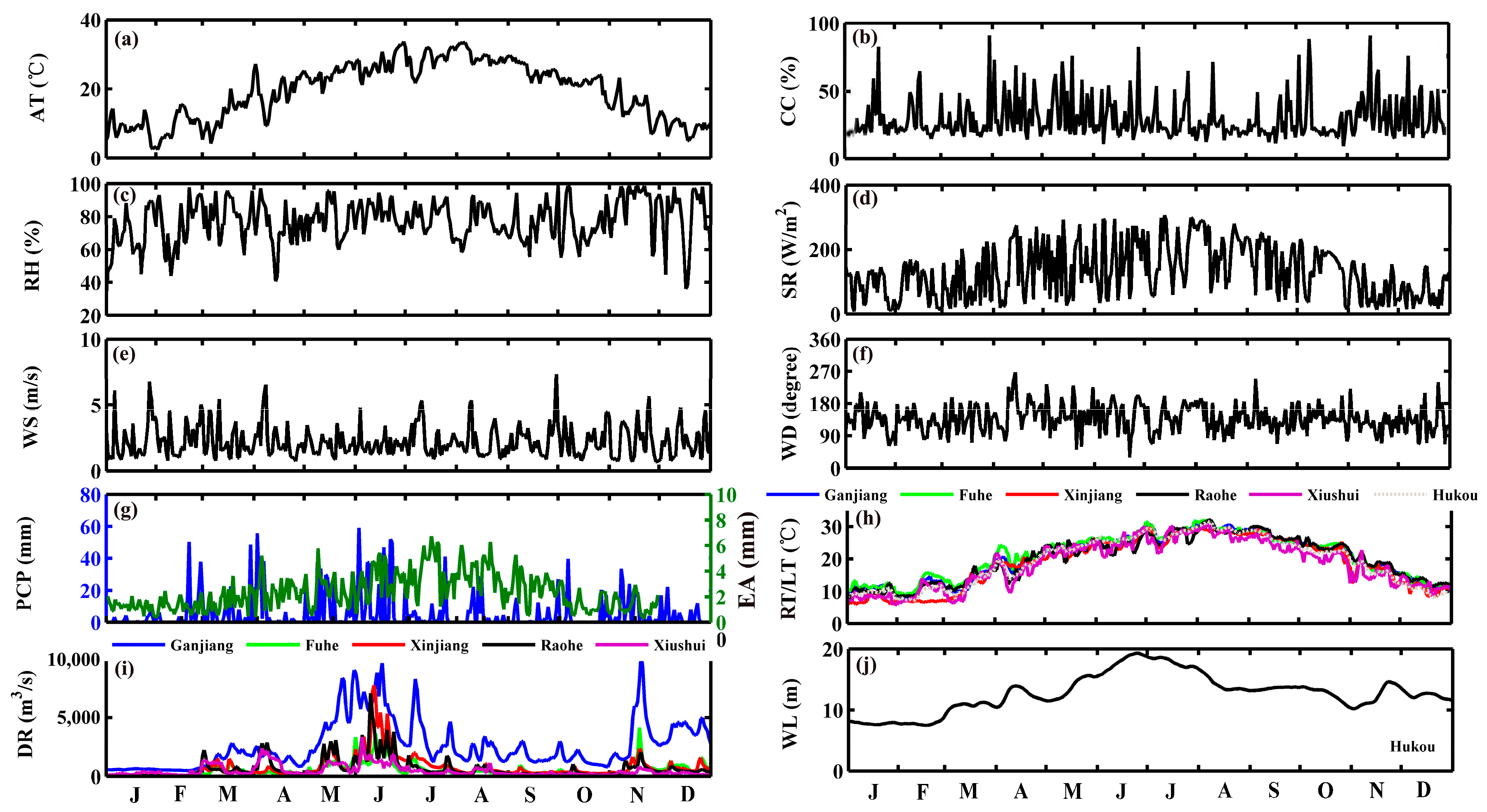
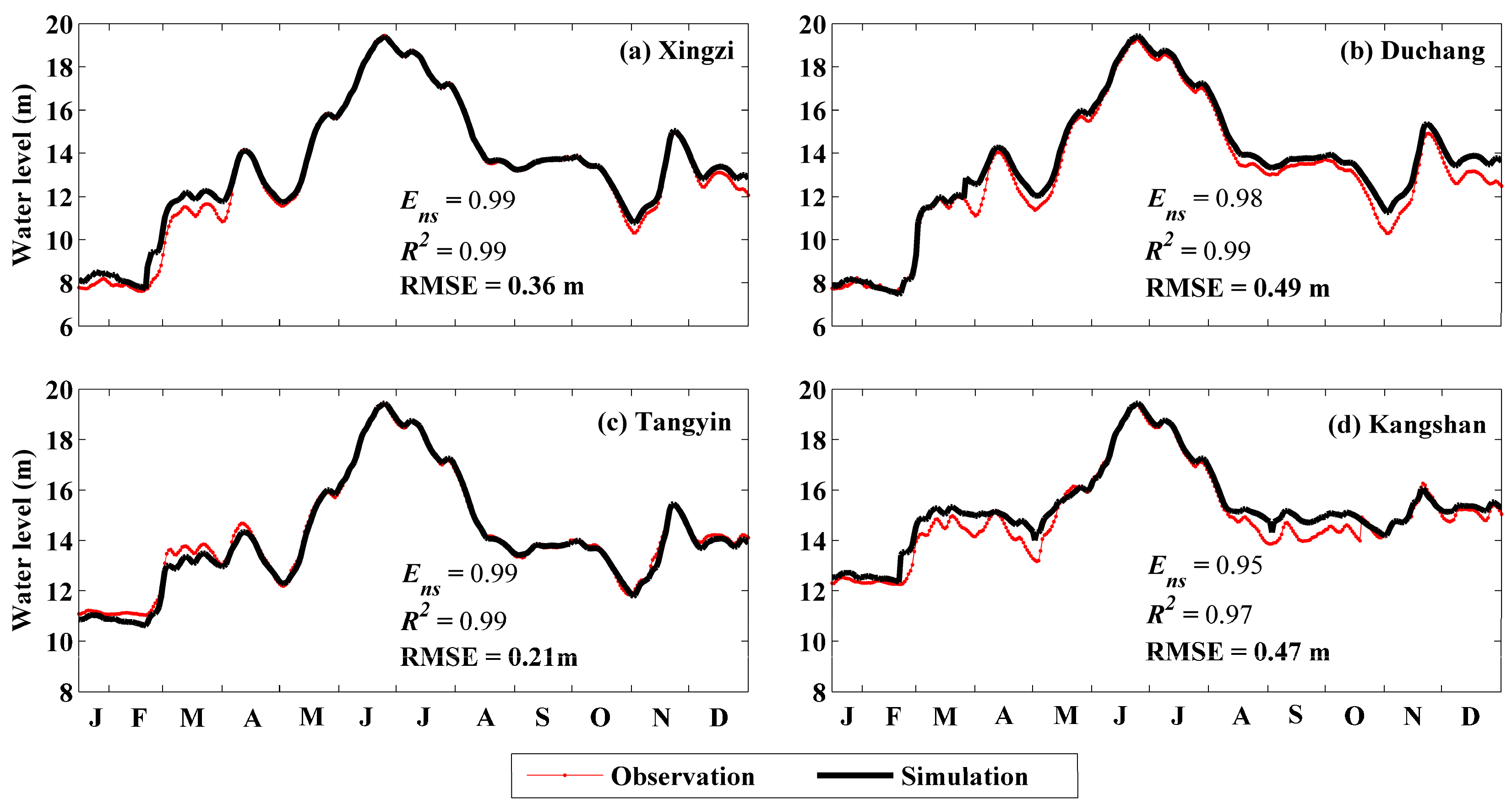
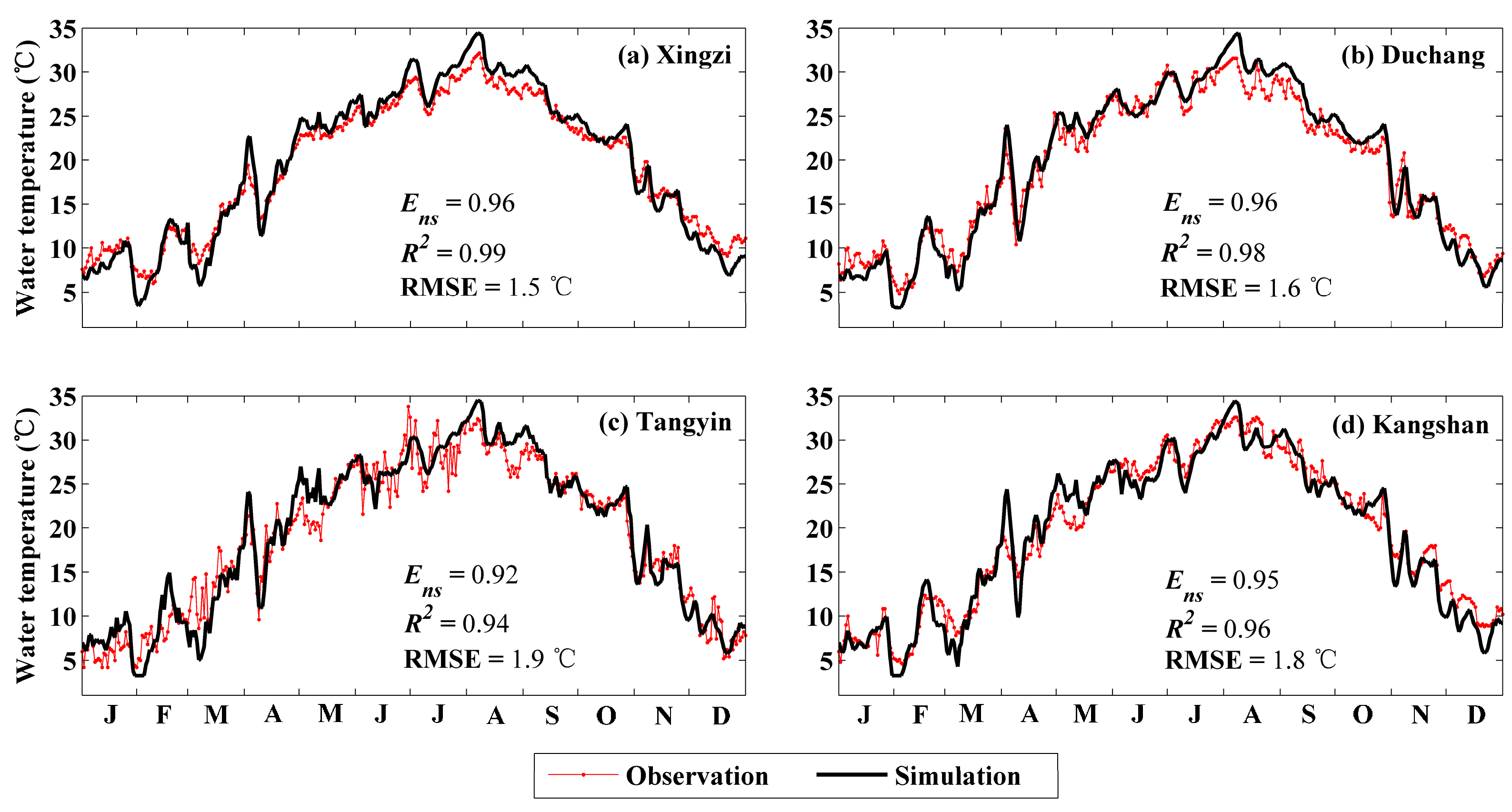

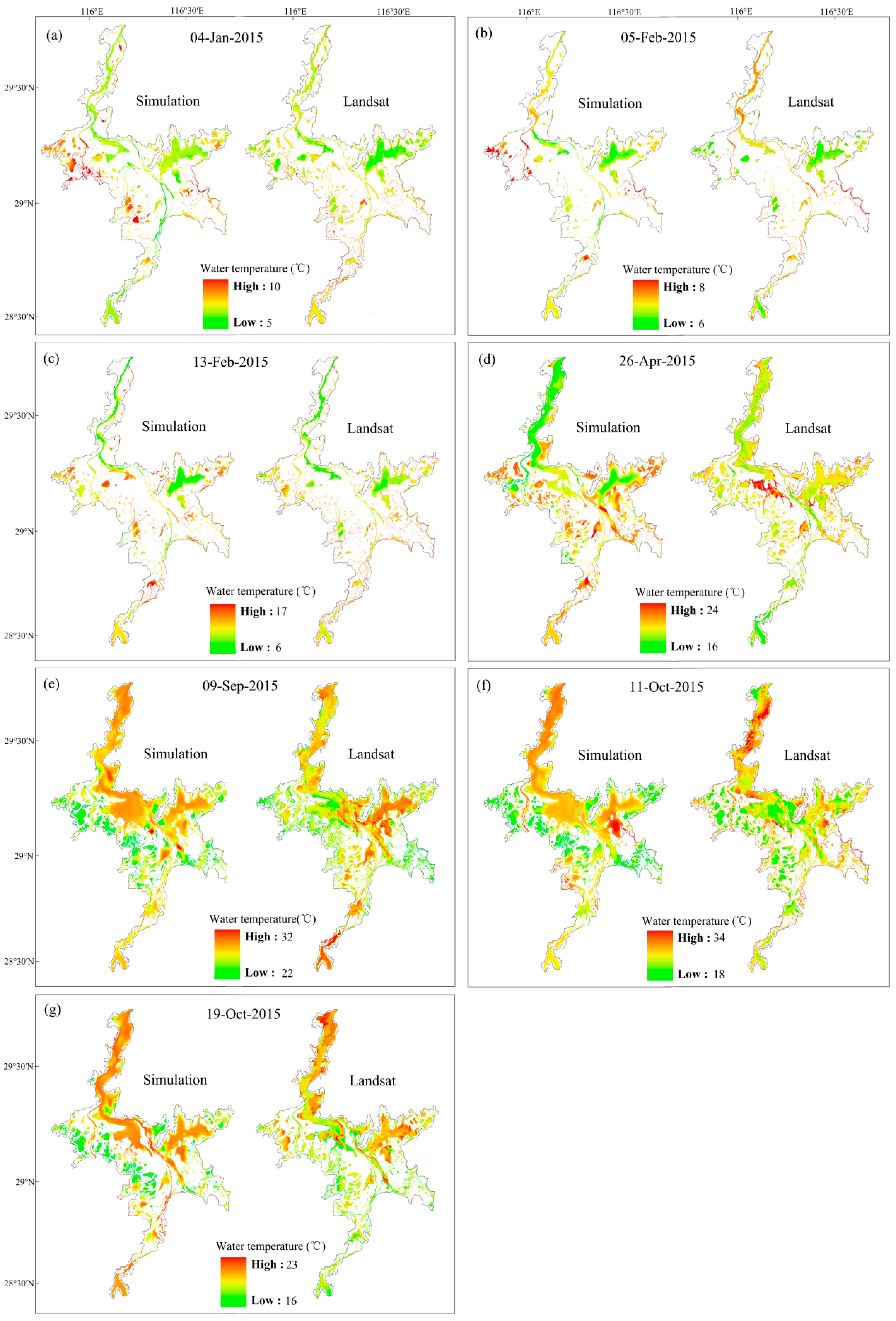
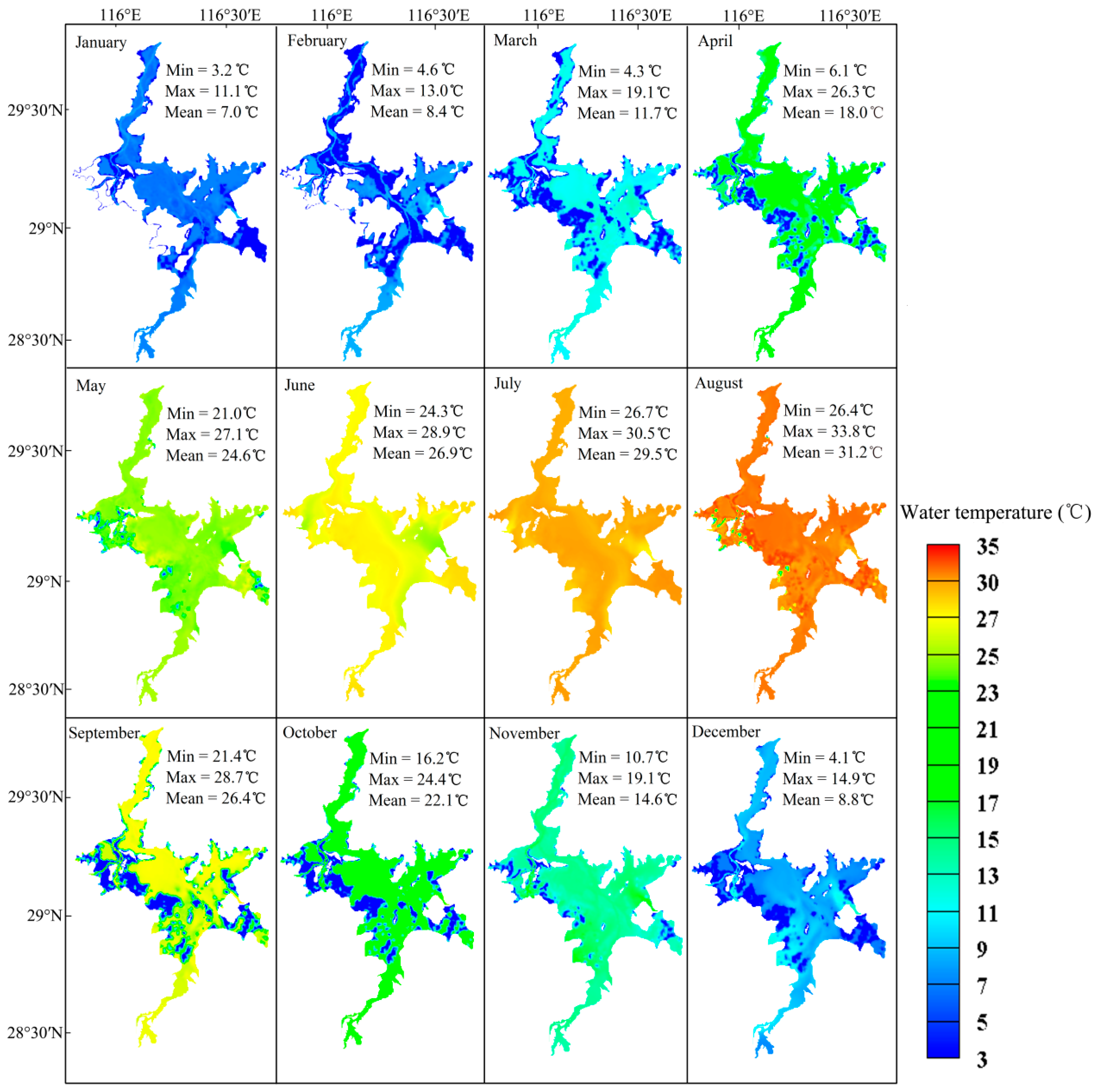
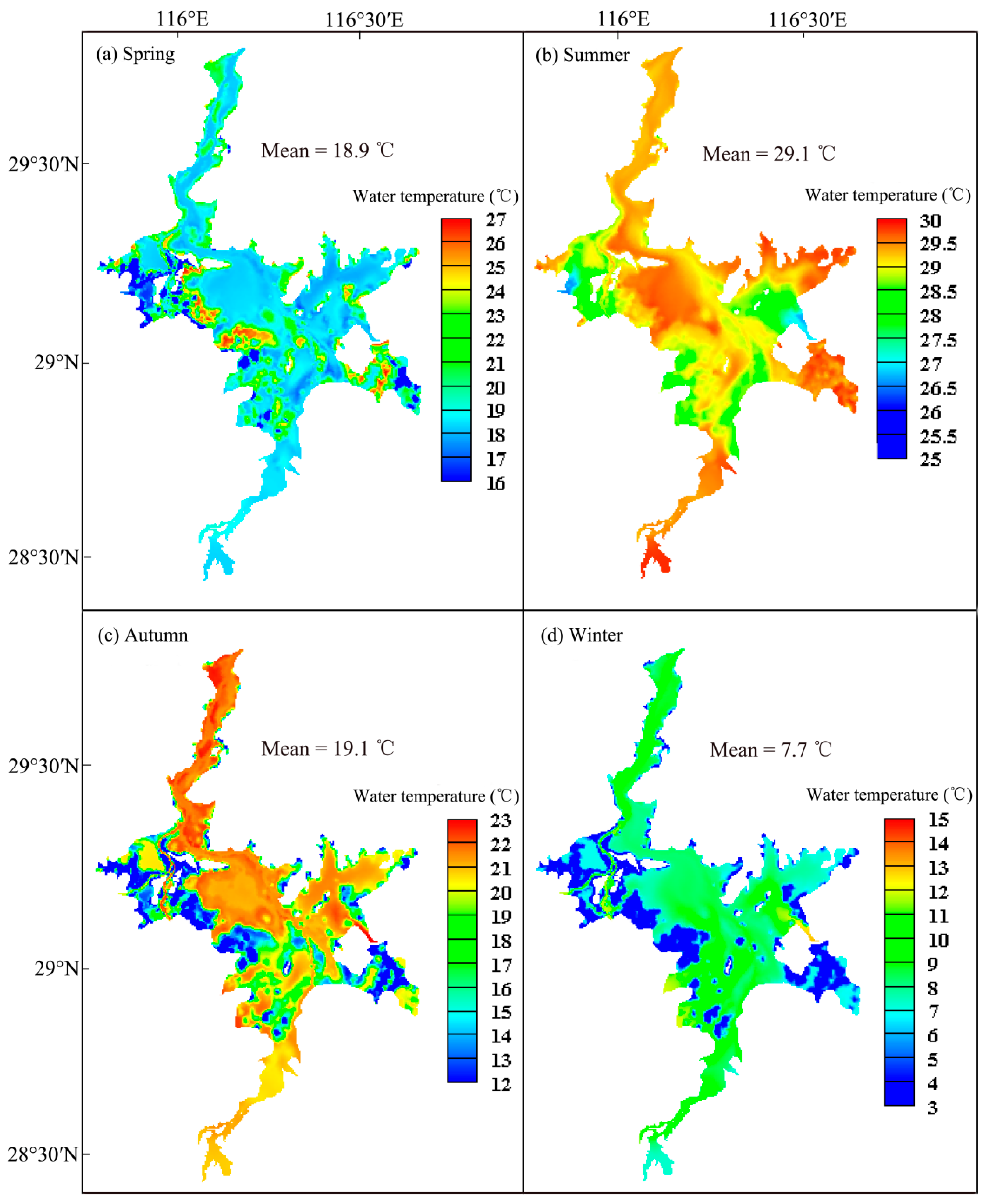
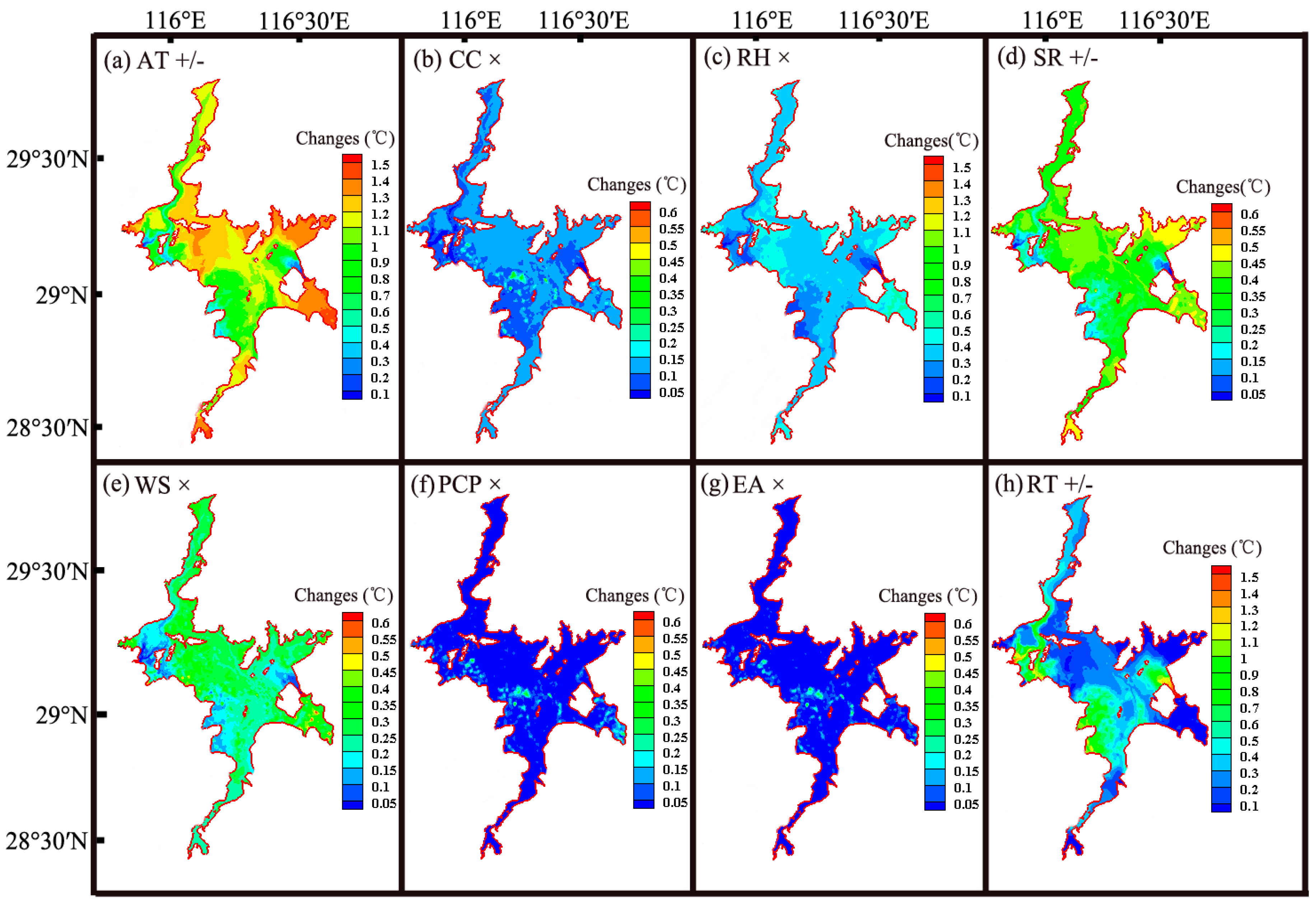
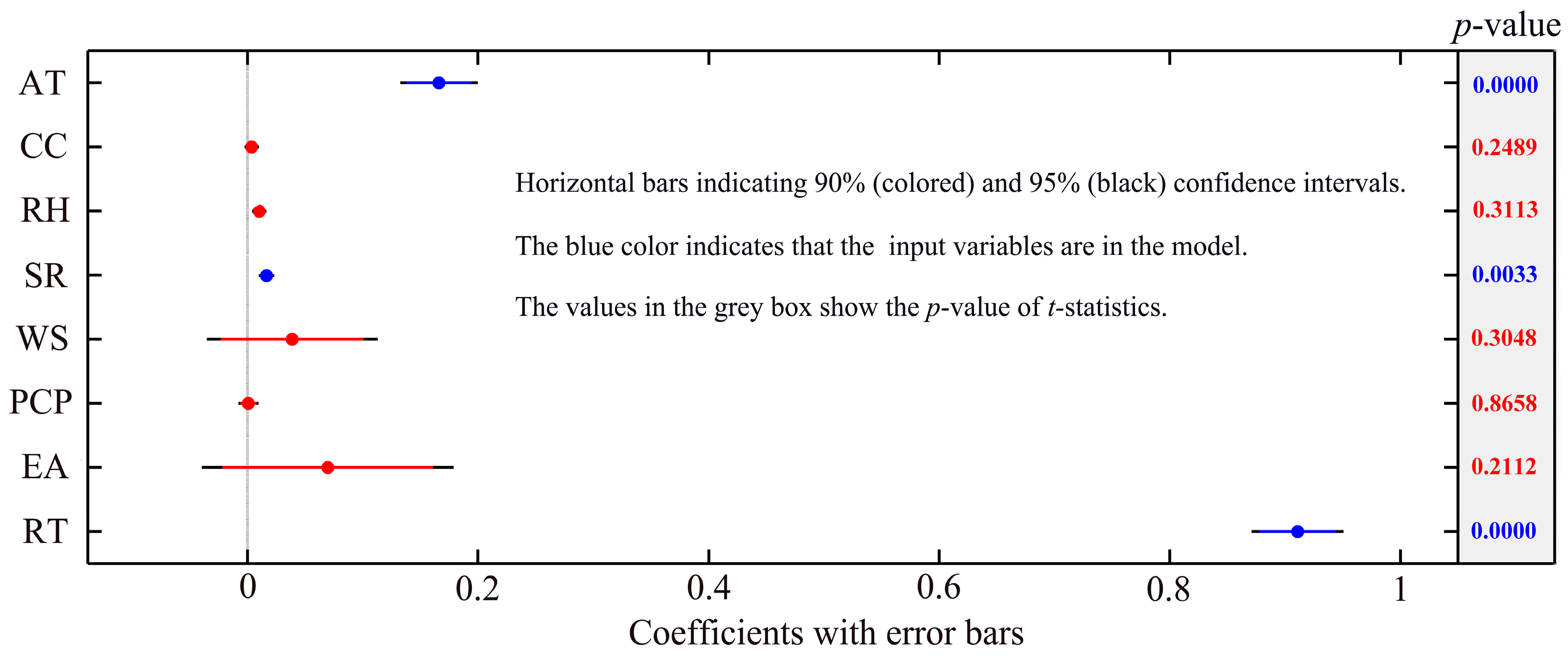
| Parameter | Gauging Station | Purpose |
|---|---|---|
| AT (°C) | Duchang, Kangshan | Meteorological conditions |
| CC (%) | Xingzi | |
| RH (%) | Duchang | |
| SR (W/m2) | Xingzi | |
| WS (m/s) | Duchang | |
| WD (degree) | Duchang | |
| PCP (mm) | Xingzi, Tangyin, Kangshan | |
| EA (mm) | Xingzi, Tangyin, Kangshan | |
| RT (°C) | Waizhou, Lijiadu, Meigang, Dufengkeng, Qiujin, Wanjiabu | Catchment effects |
| DR (m3/s) | Waizhou, Lijiadu, Meigang, Dufengkeng, Qiujin, Wanjiabu | |
| LT (°C) | Hukou, Xingzi, Duchang, Tangyin, Kangshan | Lake responses |
| WL (m) | Hukou, Xingzi, Duchang, Tangyin, Kangshan |
| Description | Value and Unit | Reference |
|---|---|---|
| Manning’s roughness coefficient | 0.02–0.03 (s/m1/3) | [42] |
| Smagorinsky factor for eddy viscosity | 0.28 (-) | [42] |
| Critical wind speed | 3.0 (m/s) | [19] |
| Light extinction coefficient | 1.0 (1/m) | [19] |
| Constant in Dalton’s law | 0.5 (-) | [48] |
| Wind coefficient in Dalton’s law | 0.9 (-) | [48] |
| Exchange coefficient in Beer’s law | 0.8 (-) | [46] |
| Transfer coefficient for healing and cooling | 0.005 (-) | [49] |
| Parameter | Variations of Parameter | Theoretical Range | ||||
|---|---|---|---|---|---|---|
| Increase | Decrease | min | max | |||
| AT (°C) | +1.0 | +2.0 | −1.0 | −2.0 | −∞ | +∞ |
| CC (%) | ×1.05 | ×1.10 | ×0.95 | ×0.90 | 0 | 100 |
| RH (%) | ×1.05 | ×1.10 | ×0.95 | ×0.90 | 0 | 100 |
| SR (W/m2) | +19.44 | +48.6 | −19.44 | −48.6 | 0 | +∞ |
| WS (m/s) | ×1.2 | ×1.5 | ×0.80 | ×0.50 | 0 | +∞ |
| PCP (mm) | ×1.05 | ×1.10 | ×0.95 | ×0.90 | 0 | +∞ |
| EA (mm) | ×1.05 | ×1.10 | ×0.95 | ×0.90 | 0 | +∞ |
| RT (°C) | +1.0 | +2.0 | −1.0 | −2.0 | −∞ | +∞ |
| Date | Simulation | Landsat | Adj-R2 | ||||
|---|---|---|---|---|---|---|---|
| Average | Min | Max | Average | Min | Max | ||
| 4 January 2015 | 7.1 | 6.8 | 9.8 | 7.5 | 5.8 | 8.9 | 0.92 |
| 5 February 2015 | 6.5 | 6.4 | 7.5 | 6.7 | 6.2 | 7.8 | 0.91 |
| 13 February 2015 | 10.7 | 6.7 | 16.3 | 10.7 | 7.4 | 14.3 | 0.92 |
| 26 April 2015 | 21.3 | 16.3 | 23.4 | 19.8 | 18.9 | 23.3 | 0.81 |
| 9 September 2015 | 28.2 | 21.8 | 31.9 | 26.5 | 24.7 | 30.9 | 0.80 |
| 11 October 2015 | 22.1 | 18.2 | 31.6 | 24.4 | 18.2 | 33.9 | 0.85 |
| 19 October 2015 | 21.5 | 15.8 | 21.0 | 22.8 | 17.3 | 23.2 | 0.87 |
© 2017 by the authors. Licensee MDPI, Basel, Switzerland. This article is an open access article distributed under the terms and conditions of the Creative Commons Attribution (CC BY) license (http://creativecommons.org/licenses/by/4.0/).
Share and Cite
Li, Y.; Zhang, Q.; Zhang, L.; Tan, Z.; Yao, J. Investigation of Water Temperature Variations and Sensitivities in a Large Floodplain Lake System (Poyang Lake, China) Using a Hydrodynamic Model. Remote Sens. 2017, 9, 1231. https://doi.org/10.3390/rs9121231
Li Y, Zhang Q, Zhang L, Tan Z, Yao J. Investigation of Water Temperature Variations and Sensitivities in a Large Floodplain Lake System (Poyang Lake, China) Using a Hydrodynamic Model. Remote Sensing. 2017; 9(12):1231. https://doi.org/10.3390/rs9121231
Chicago/Turabian StyleLi, Yunliang, Qi Zhang, Li Zhang, Zhiqiang Tan, and Jing Yao. 2017. "Investigation of Water Temperature Variations and Sensitivities in a Large Floodplain Lake System (Poyang Lake, China) Using a Hydrodynamic Model" Remote Sensing 9, no. 12: 1231. https://doi.org/10.3390/rs9121231
APA StyleLi, Y., Zhang, Q., Zhang, L., Tan, Z., & Yao, J. (2017). Investigation of Water Temperature Variations and Sensitivities in a Large Floodplain Lake System (Poyang Lake, China) Using a Hydrodynamic Model. Remote Sensing, 9(12), 1231. https://doi.org/10.3390/rs9121231






